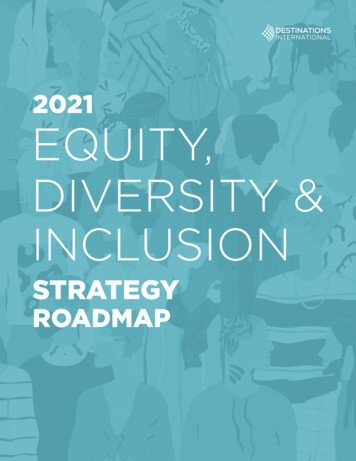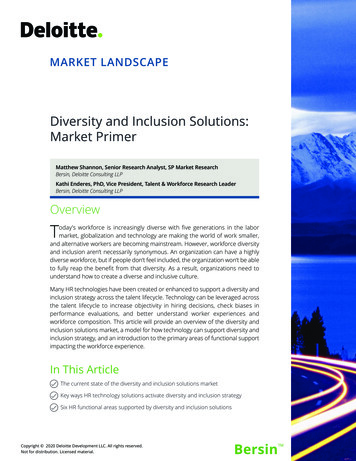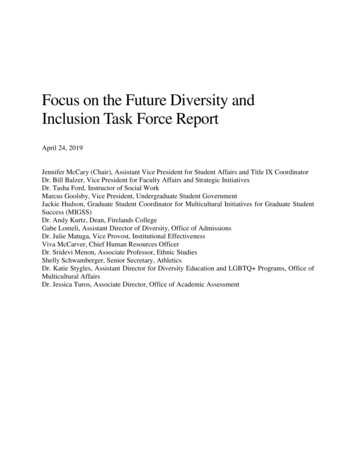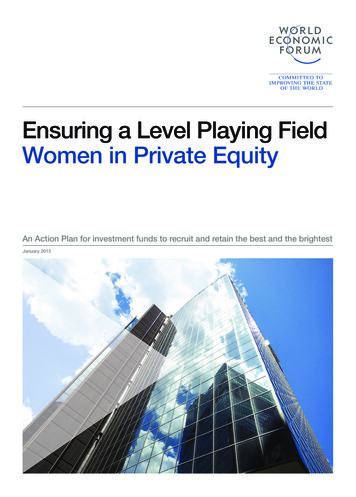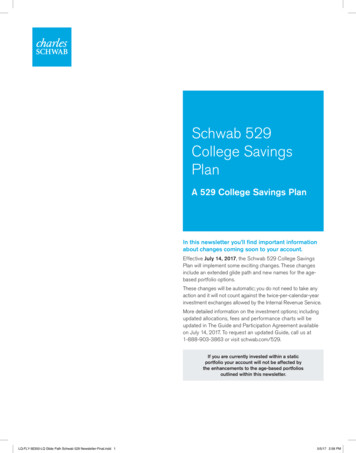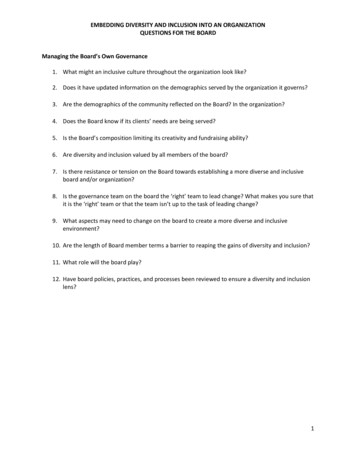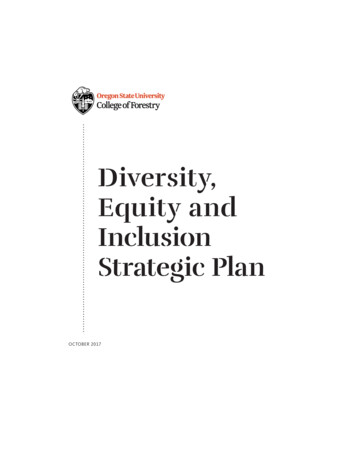
Transcription
Diversity,Equity andInclusionStrategic PlanOCTOBER 2017
Table of ContentsI. PREFACE2II. BACKGROUNDA. IntroductionCoF DEI VisionCoF DEI MissionB. Definition of TermsC. Planning Process OverviewMeet and Define ScopeCollect DataBrainstorm SolutionsGather FeedbackDevelop Strategic Plan33334444556III. IMPLEMENTATION7A. Themes and Goals7B. Leadership Structure8Rationale forLeadership Structure8Coordinator Considerationsand Responsibilities8Committee Charge, Compositionand Selection Process9C. Strategies and Actions10IV. APPENDICESAppendix AList of Participants in DEIPlanning ProcessAppendix BGlossary of TermsAppendix CKey Findings from SubcommitteeResearch & DiscussionsAppendix DResults from Spring 2016College of Forestry DEI Survey202020222223232525I. PrefaceThis plan to Enhance Diversity, Equity and Inclusion (DEI) in the Collegeof Forestry (CoF) builds on the 2008 CoF Diversity Action Plan (DAP),and many of the components and definitions have been adapted fromthe DAP. Faculty, staff, and students from across the college contributedto the development of this current DEI plan via workgroups, opendiscussions, and background research. (See Appendix A for a completelist of participants.)This plan outlines the high-level goals, strategies, and concrete actionsthe College will take to achieve its objectives to enhance diversity, equityand inclusion:1. Promote innovation in research and teaching by enhancing creativitythrough diversity.2. Ensure equity of opportunity to all persons who work or study at theCollege of Forestry.3. Create a culture of inclusivity and respect within the College and ininteractions with partners.This document describes the process and outcomes of the 18-monthplanning process. This plan is intended to be a living document thatwill be refined and updated by a DEI Coordinator and Committee.The introduction reaffirms the college vision and mission and explainsthe background and need for a plan. It is followed by a set of workingdefinitions of terms, which is critical to ensure common understandingof these challenging concepts. The document then describes the processused to develop the plan, which resulted in four broad “themes” anda set of goals within each theme. The section on leadership structuredescribes the intended future process by which a coordinator andcommittee will refine, flesh out, and prioritize specific actions overthe first five years of the plan’s adoption. Finally, a set of strategiesand actions developed by working groups and a core planning teamare presented in a table showing likely responsible parties, suggestedpriority, and target implementation phase.OSU DEI VISIONOregon State University aspires to be a collaborative, inclusiveand caring community that strives for equity and equal opportunityin everything we do; that creates a welcoming environment andenables success for people from all walks of life; and that sharescommon, fundamental values grounded in justice, civility andrespect while looking to our diversity as a source of enrichmentand strength.OSU DEI PRINCIPLESAn inclusive university community is achieved and sustainedby seeking a diversity of people and perspectives, valuing ourdifferences and ensuring equitable opportunities. We are guidedby the interdependent principles of Inclusion, Equity, and Diversity.We are steadfast in our pursuit of equity, inclusion, and diversity.These commitments are central to our OSU mission—to fosteracademic excellence, to build healthy communities, and to improvethe quality of life at our university and throughout the world.DEI STRATEGIC PLAN2
II. BackgroundA. INTRODUCTIONThe College of Forestry has engaged with issuessurrounding diversity, equity, and inclusivity for manyyears, with a notable milestone being the DiversityAction Plan adopted in 2008. The current DEI plan tiesto the University’s vision and principles and builds onprior CoF efforts, adapting its vision and mission fromthe 2008 Diversity Action Plan:COF DEI VISIONThe College of Forestry will embrace the distinctivequalities of all members of its community. Werecognize that equity, inclusion, and diversity arefoundational values of OSU as an institution and pillarsof excellence, enhancing all of the College’s missions.COF DEI MISSIONThe College of Forestry aspires to create anenvironment in which all members of the communityfeel safe, respected, and free at all times to participatein various undertakings of the college, includinglearning, teaching, administration, and research.The need for direct, active, and honest attention toequity, inclusivity, and diversity is as urgent todayas ever. Our world faces social, economic, andenvironmental challenges of unprecedented complexityand scale. The paradigm shift towards embracingequity and inclusivity across our university andparts of the world opens up immense opportunitiesfor learning and growth. However, the College ofForestry also faces challenges as we strive to becomea more diverse, inclusive, and equitable community.In particular, perspectives on natural resource issuescan be emotionally and politically charged, andforestry professions in the west have historically notbeen representative of all peoples, identities, andperspectives. Thus, we have the opportunity andobligation to be catalysts for change in the state,nation, and world by nurturing a culture that respectsdiverse perspectives and approaches to naturalresource issues. The College of Forestry is committed toaddressing those challenges in the realm of forestry andnatural resource management – whether it be througheducation, research, or public engagement. We intendto draw fully and inclusively on the power and force ofthe human imagination, experience, and creativity tomeet the needs of today’s world.Diversifying our College community is one of fivestrategic priorities to build the vision of the Collegeof Forestry as a world-class education, research, andoutreach center for healthy landscapes, communities,and businesses. Priority Five directs efforts to “drivetoward a more diversified, pluralistic college communityfounded on collegiality and respect.” The relevance ofdiversity and inclusivity to the forestry profession andrelated disciplines is outlined in Dean Maness’ visionstatement for the College of Forestry: “Graduates of theCollege will work in diverse communities and culturesaround the world. A diverse and inclusive Collegecommunity increases our cultural and ethnic awarenessand enriches the educational experience. Working indiverse teams fosters understanding and respect forindividuals and dispels stereotypes. It increases ourcommunication skills and allows us to work better withpeople from many different backgrounds.”This strategic plan sets the college on a path towardaccomplishing this priority by describing actions wewill take to build awareness of the need for equity andinclusivity; create a welcoming climate and culture inthe college; diversify the faculty, staff, and studentbody through improved recruitment and retention; andfoster and reward actions that promote a pluralisticcommunity culture that will help ensure the institutionallongevity of our commitment. This plan providesconcrete actions designed to seize opportunities andovercome challenges to enhancing diversity, equity andinclusion in the College.Many questions arose throughout the planning process,including “what does it mean to welcome difference?”,“how do we encourage critical self-reflection?”,and “what are the main barriers to recruitment andretention of diverse faculty, staff and students?” Akey feature of this plan is a recognition that we donot have all the answers. Additionally, throughoutthe planning process, participants recognized theresource constraints associated with the time andmoney required to accomplish the plan’s goals.Therefore, the plan adopts an adaptive managementapproach, in which we will take action, assess ourprogress, and revise our strategies based on what wefind. The actions developed by the working groupsand presented here are based on thoughtful review ofdocuments from peer institutions, lengthy discussionsabout feasibility and impact, and an eye toward a suiteof actions that give us the best likelihood of success.They represent the planning team’s current bestefforts to incorporate all the input received over 18months, but it is explicitly recognized that the detailsof who, what, where, when, and how will be workedout through a transparent, inclusive process led by acoordinator and college-wide committee.DEI STRATEGIC PLAN3
VESSC. PLANNING PROCESS OVERVIEWREISTRACKTACINCLUSION is working together to create an open andwelcoming environment that respects and affirms theinherent dignity, value, and uniqueness of all individualsand groups. Inclusive practices reflect awareness andunderstanding of the complexity of identity and thediversity in the world. (Adapted from Oregon State SelfStudy Vision, 2011)A SSEThis plan adopts an adaptive management approach,in which we will take action, assess our progress,and revise our strategies based on what we find. Itdoes not finalize the specific details of actions orassign tasks to individuals; those steps will be takenthrough a transparent, inclusive process led by acoordinator and college-wide committee.B. DEFINITION OF TERMSConcepts and terminology used in plans such as thiscan vary considerably, and usage evolves over time. Toensure that readers and members of the College sharean understanding of how this plan uses terminology,definitions of key words and phrases are providedbelow. Additional specialized terms and references aredefined in Appendix B.DIVERSITY is the spectrum of differences membersof the College of Forestry bring to our communitythrough their variety of backgrounds, experiences, andviews. These differences include but are not limitedto, race, ethnicity, culture, gender, sexual orientation,socioeconomic status, age, physical and cognitiveabilities, national origin, religious and political beliefs,education, marital status, language, veteran status,worldviews, and other characteristics and ideologies.Embracing diversity is about moving beyond toleranceto understanding and appreciating each other byrespecting and celebrating diversity in each individualand the college as a whole. (Adapted from the OSU CoFDiversity Action Plan, 2008)EQUITY is the guarantee of fair treatment and accessto opportunities that provides the chance for everyoneto succeed. Equity seeks to reduce barriers that preventsome groups and individuals from fully participating.(Adapted from UC-Berkeley Strategic Plan for Equity,Inclusion, and Diversity, 2009)More than 100 faculty, staff, and students participatedin one or more phases of the College’s DEI planningprocess from January 2016 through June 2017. Beyondthese individuals, others contributed their input througha college-wide climate survey conducted in June 2016.Throughout the planning process, different collections ofindividuals participated in different activities; some peopleparticipated in all or nearly all activities, while othersparticipated in a single session. A core group of sevenindividuals led the writing process in the final six monthsof plan development.MEET AND DEFINE SCOPEIn February 2016, approximately 35 faculty, staff, andstudents gathered in open forums and working meetingsto discuss issues and how to address diversity, equity andinclusion in the College. The group started by reviewing theCollege’s 2008 Diversity Action Plan (DAP) and decidedto retain the three focal areas of (1) creating a welcomingclimate, (2) increasing diversity, and (3) broadeningawareness. Based on a review of comments from membersof the college who were concerned about the ability tomaintain momentum – as well as recommendations frompeer institutions and published literature – the meetingconveners suggested adding a fourth category: ensuringthe sustainability of this initiative (institutional longevity).Additionally, the group recognized the importance ofincreasing equity and inclusion alongside diversity, anddecided to expand the second focal area to cover equityand inclusion as well. The group subsequently split into foursubcommittees, one for each focal area (or theme). Eachsubcommittee investigated questions related to its theme.COLLECT DATAEach subcommittee gathered information and resourcesto help describe issues, establish priorities, and proposeideas for actions to take within CoF related to its theme.Activities included reviewing documents and websites frompeer institutions, scanning research related to DEI issues,and holding discussions with specialists from across OSU.This step surfaced many potential strategies and actionsthat could be implemented in CoF. It also helped refinethe planning process; at this step, work published by UCBerkeley was particularly instructive. Key findings fromDEI STRATEGIC PLAN4
MEET ANDDEFINE SCOPEFeb 2016subcommittee researchand discussions areavailable in Appendix C.In spring 2016, theWelcoming ClimatesubcommitteeCOLLECTconducted a collegeDATAwide climate survey, withMar - June 2016responses submittedby 250 individuals.Participants were askedquestions about theirBRAINSTORMpersonal perceptionsSOLUTIONSand experiences inJuly 2016the college as theyrelate to diversity,equity, and inclusion.GATHERThe purpose of theFEEDBACKsurvey was to prioritizeDec 2016 - Feb 2017areas of concern andto establish baselinemetrics. Detailed surveyresults are available inDEVELOPAppendix D. In general,STRATEGIC PLANthe survey helpedFeb - June 2017illustrate that there aredifferent perceptionsand experiences among different groups in the college,with some groups and individuals having experiencedor witnessed problematic behaviors. While a majorityof respondents feel the college is working to improvediversity and create a welcoming climate, a notablesegment either did not agree or did not feel sufficientlyinformed to have an opinion. The findings reaffirmedthe need for a DEI plan and actions to be taken.BRAINSTORM SOLUTIONSIn July 2016, 20 faculty, staff, and students participatedin a two-day retreat. After reviewing the materialscompiled by the subcommittees and the results of theCoF climate survey, participants discussed relevantfactors and assumptions and drafted goals, strategies,and actions for each of the four themes. A charrettestyle poster session on the afternoon of the second dayled to refinement, addition, and combination of variousactions. The outputs from the retreat were compiledinto a draft planning document, with most efforts atthis point focused on refining strategies and actions.GATHER FEEDBACKFollowing the 2016 retreat, various activities wereundertaken to continue to provide opportunities forthe community to reflect on and contribute to thedeveloping plan. The Forestry Executive Committeewas briefed on the climate survey and retreat outcomesin summer 2016. In fall and winter, presentations weremade to the FES and FERM departments at a regularlyscheduled department meeting.FACULTY, STAFF, ANDGRADUATE STUDENT FEEDBACKAll faculty, staff, and graduate students in the Collegewere encouraged to provide feedback on the draftplanning document (i.e., the goals, strategies, andactions) in one of three ways: (1) participating infocus group discussions with their peers, (2) meetingindividually with a facilitator, or (3) submittingcomments via an anonymous online survey. Toencourage honest discussion and avoid hierarchicalrelationships amongst participants, focus groupparticipants were invited based on position in theCollege. Two CoF members, who were not part of theCollege leadership, facilitated the focus groups andthey assured confidentiality of participants’ feedback.Forty-eight people participated in the focus groups;two people met individually with a facilitator; and ninepeople completed the online survey. Eight focus groupswere held from December 2016 - February 2017 andthe online survey was available from February 28 March 15, 2017.Prior to attending the focus groups, participants wereasked to fill out a worksheet identifying the threehighest priority actions and the three most feasibleactions for each theme from the complete table ofactions provided to them. Participants were also askedto describe, for each theme, why they considered theirthree actions as highest priority, to list any anticipatedchallenges, opportunities or constraints, and to listany strategies or actions that were missing from thedraft planning document. During the focus groups,participants discussed their choices in small groups of3-4 people while a facilitator took notes and answeredquestions. As a result of discussing their selections withtheir peers, some participants changed which actionsthey designated as highest priority or most feasible.The facilitators collected each participant’s worksheet,tabulated responses for the highest priority and mostfeasible actions, and summarized the content of thefocus group discussions.UNDERGRADUATE STUDENT FEEDBACKUndergraduate students also had an opportunityto prioritize strategies and actions from the draftplanning document developed at the summer retreat.Representing approximately 20% of the Corvallisbased CoF undergraduate population, 72 studentsDEI STRATEGIC PLAN5
ONLINE SURVEY OFUNDERGRADUATESTOTALAfter the in-class sessionswere completed, all CoFundergraduate students who5were not enrolled in the three3selected courses were offered8a comparable opportunity to12rate DEI priorities via an onlinesurvey. The survey included the11same open-ended questions as9those presented on the in-classquestionnaire. On a scale of48zero to ten, from least to mostimportant, students were askedto rate the priority of the eight items. Out of 29 onlinestudent responses, the initiative “hosting open forumsand discussions that provide a welcoming space todiscuss DEI” was rated as a 10 in importance by thelargest proportion of students (n 8). The highestaverage was 7.4 out of 10 for the action “receivingfunding support to participate in study abroad andinternational opportunities and study abroad programs.”TABLE 1: NUMBER OF FOCUS GROUP PARTICIPANTS BY CONSTITUENCY GROUPGROUPDEPARTMENTFERM FESWSENONEGraduate StudentsInstructorsResearch Support FacultyProfessional Faculty & StaffTenured FacultyTenure-Track Faculty111031427246000142000900TOTAL72579provided feedback during the in-class sessions, and29 students submitted feedback via an online survey.Prior to involving the undergraduate students, the DEIworkgroup consolidated the strategies and actionsthat were most relevant to undergraduate studentsinto eight items, rather than giving the studentsthe entire draft planning document. The studentsranked or rated these eight items, which ranged fromintegrating DEI into curriculum, to disseminating DEIinformation and resources.IN-CLASS SESSIONSTo receive feedback from a large number ofundergraduate students, the workgroup sent requeststo the faculty teaching CoF classes with the largestenrollment during the Fall 2016 and Winter 2017 terms.The CoF DEI workgroup selected three undergraduateclasses, one from each department in the College, tohold short in-class focus group sessions. During the30-minute sessions, the students had 15 minutes tocomplete the questionnaire, which included the priorityranking, as well as several open-ended questionsabout their experience with Difference, Power, andDiscrimination courses and other relevant topics.During the final 15 minutes, the students split intosmall groups to discuss their priorities and otherinitiatives they would like included in the DEI plan. Anynon-CoF affiliated students enrolled in these classes didnot complete the short survey but were encouraged toparticipate in the small group discussions. The highestpriority across all three in-class sessions was “providingfunding support for study abroad opportunities,” which33 percent of the in-class students ranked as theirtop priority. Eighteen percent of in-class participantsranked “recruiting and retaining diverse students” astheir highest priority. With 11 percent ranking it astheir highest priority, the third most cited priority was“requiring DEI training for faculty.”DEVELOP STRATEGIC PLANFrom February through June, 2017, a workgroupconsisting of seven CoF members (one departmenthead, five faculty, and one graduate student) revisedthe draft planning document generated at the retreatto incorporate feedback received from the focus groupsand online surveys. The workgroup was comprised ofindividuals working in various college roles, who arefamiliar with existing resources and time requirementsto achieve these actions. The workgroup began byreviewing the priorities and feasibility rankings thatCoF faculty, staff, and students had assigned to all theactions. Similar actions were consolidated and actionsunrelated to DEI were removed. Aside from a handfulof actions consistently ranked high priority, there wasno strong consensus that a subset of items was rankedconsistently high or low priority. Instead, most actionswere ranked high (or low) by several people. Hence,the decision was made to retain nearly all actions inthe final plan and to let a future DEI Coordinator andCommittee decide how to establish priorities. Theworkgroup separated the actions into three suggestedimplementation phases (1-2 years, 2-3 years, and3-5 years). When deciding the phases, the groupconsidered the feedback given during the 2016-2017focus groups regarding the priority and feasibility ofeach action. For example, some actions are alreadybeing undertaken or are easy to implement with fewadditional resources (and hence reasonably belong inDEI STRATEGIC PLAN6
the first phase). Other actions will require additionalresearch or resources, and therefore likely cannot beimplemented until a later phase.In May 2017, 34 faculty, staff, and students attendedone of two open forums hosted by the DEI workgroup.Three members of the workgroup presented anoverview of the plan and then facilitated a 30-minutequestion and answer session. The workgroup discussedthe questions raised at the forums and added a fewnew actions to the plan. Several of the questions anddiscussion points did not have immediate answers,and workgroup members explained that the newDEI Committee will address these questions andsuggestions once the committee is appointed (seeleadership section for more).Simultaneously with the steps over winter and spring2017 to finalize the plan’s strategies and actions, theplanning workgroup drafted the other componentsof the plan, including the plan’s introduction,documentation of process, and various appendices.III. IMPLEMENTATIONA. THEMES AND GOALSFour themes and the goals within those themesprovided direction to develop the strategies andactions (see section III C) that will facilitate planimplementation. As noted above, the first three themeswere adapted from the 2008 College of ForestryDiversity Action Plan. The Institutional Longevity themewas added to provide necessary support to implementthe strategies and actions in the other three themes,while also ensuring long-term sustainability of diversity,equity, and inclusion efforts in the College.THEMES1. Building Awareness2. Welcoming Climate3. Enhancing Diversity, Equity, and Inclusion4. Institutional LongevityMany of the actions could be categorized into multiplethemes due to the interconnectedness of the themes(in particular, there was overlap among items inBuilding Awareness and Welcoming Climate, as actionstaken to further one will likely further the other). Forexample, trainings to expand our awareness of DEIissues (Building Awareness) ideally will help promotea welcoming climate. To the extent possible, the planincludes actions under the theme that the workgroupfelt was most CINGDEIINSTITUTIONAL LONGEVITYBUILDING AWARENESSBuilding awareness means increasing DEI foundationalknowledge and providing support to increaseawareness of DEI among CoF members. We willprovide learning opportunities for each member of thecollege to understand DEI issues, recognize appropriatebehaviors, know their rights, and acknowledge thebenefits of enhancing DEI.GOALS1. Cultivate a community of students, staff, faculty, andexternal partners that is competent in knowing aboutand exemplifying diversity, equity, and inclusion valueswithin CoF and beyond.2. Increase exposure to other cultures and ways ofthinking and learning.WELCOMING CLIMATEWe will create and present an environment that valuesand promotes diversity of all CoF members and guests byfacilitating their full inclusion into the community. Fosteringa welcoming climate requires each person to respectdiverse perspectives, engage in appropriate conduct,recognize implicit bias, and reduce barriers to participation.GOALS1. The College of Forestry, through its words andactions, genuinely welcomes, values, and includes allof its members, who have diverse backgrounds andperspectives. The College presents itself as a welcomingand inclusive community that values the contributionsof all its members and serves as a beacon for others.2. All College of Forestry members and guests will haveaccess to the college’s physical spaces and intellectualcommunity. The college is a home for learning andpersonal development.DEI STRATEGIC PLAN7
ENHANCING DIVERSITY, EQUITY AND INCLUSIONWe will enhance diversity, equity, and inclusion in theCollege of Forestry through programs targeted at bothrecruitment and retention of diverse students, faculty,and staff.GOALS1. Understand barriers to DEI in general and specificto forestry and natural resource management. Usefindings to guide plans for improving DEI.2. Improve the representation and inclusion of diversityand underrepresented groups in CoF via recruitmentand retention.3. Increase our national and international reputation asan inclusive center of academic excellence.INSTITUTIONAL LONGEVITYTo ensure the long-term implementation andsustainability of this initiative, we will make addressingDEI an integrated, consistent, meaningful and continualpart of the CoF community. We recognize that thesuccess of this long-term plan relies on our ability toweave DEI principles into all of the College’s decisions,programs, and activities.GOALS1. Develop appropriate policies and structures forcontinued dialogue and practice around issues of DEI.2. Ensure that perspectives around issues of DEI areincluded in planning and decision making in all units ofthe college.3. Coordinate activities and reporting across all CoF DEIthemes to keep issues salient.B. LEADERSHIP STRUCTUREThe College of Forestry Diversity, Equity, and InclusionPlanning Workgroup proposed the following leadershipstructure for the implementation of the DEI StrategicPlan. These recommendations reflect input receivedfrom the original larger planning group, the 2016 CoFretreat, focus groups, and reviews of peer programsfrom across the country.RATIONALE FOR LEADERSHIP STRUCTUREThe planning workgroup proposes that the CoF DEIleadership be comprised of a coordinator and a collegewide committee to ensure sustained leadership androtating involvement. There was strong support for acoordinator by College members who provided inputto the plan, and reviews of other programs provideclear evidence that a coordinator is necessary for suchefforts to be sustainable. To ensure broad ownershipof and participation in plan implementation, many CoFmembers also suggested establishing a committeeto provide opportunities for rotating leadership.Therefore, the Dean of the College will appoint acommittee (as explained below). The coordinatorwill chair the committee and organize its efforts. Thedean, associate deans, and department heads arealso expected to provide college-wide support andaccountability for DEI efforts.While the coordinator and committee will havesubstantial responsibilities for leading planimplementation, it is explicitly recognized that theymay not have sufficient knowledge or the appropriateauthority to develop and implement all actions. Forexample, actions relating to promotion and tenureguidelines must be developed in concert with thefaculty at large and departmental P&T committees.Likewise, curricular changes must engage the curriculumcommittees for each degree program. Therefore, itis most appropriate to view the DEI Committee asfacilitators and leaders; the committee will engageappropriate individuals and constituencies throughoutdevelopment and implementation of actions. Part ofthe annual reporting requirement will be to explain howa transparent, inclusive, and appropriate process wasused to develop the specific elements of how, when,where, and by whom each action will be implementedand assessed.COORDINATOR CONSIDERATIONSAND RESPONSIBILITIESThe dean will appoint an existing CoF employee¹ tocoordinate DEI efforts across the college. The coordinatorshould receive a minimum FTE allocation of 0.5. Thisindividual will report directly to the dean and associatedeans regarding their DEI-related responsibilities.APPOINTMENT CONSIDERATIONS:a. This position requires a person with a high level ofinstitutional knowledge and subject-matter expertisein diversity, equity, and inclusion best practices.b. This position requires a person committed tocoordinating the strategic plan for the long term to ensurethe sustainability of DEI implementation in the College.c. The position requires a person with excellentcommunication, facilitation, and organizational skillsIn this document, we use “employee” broadly to encompass classified staff, professional faculty, tenured, tenure track, nontenure track faculty, instructors, and research support faculty.1DEI STRATEGIC PLAN8
and demonstrated ability to lead groups in an inclusiveand equitable fashion.d. The dean will appoint the coordinator to a fixed term,with the possibility of renewal.THE COORDINATOR WILL:a. Lead the CoF DEI Committee as chair and provideplan
DEI STRATEGIC PLAN 2 I. PREFACE This plan to Enhance Diversity, Equity 2 II. BACKGROUND 3 A. Introduction 3 CoF DEI Vision 3 CoF DEI Mission 3 B. Definition of Terms 4 This plan outlines the high-level goals, strategies, and concrete actions C. Planning Process Overview 4 Meet and Define

